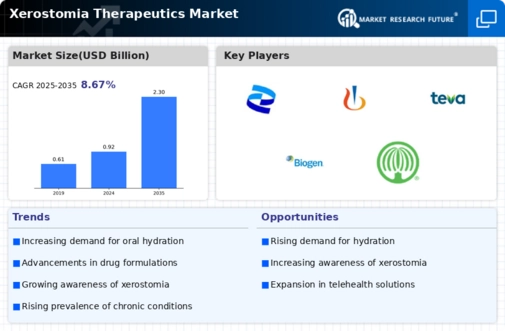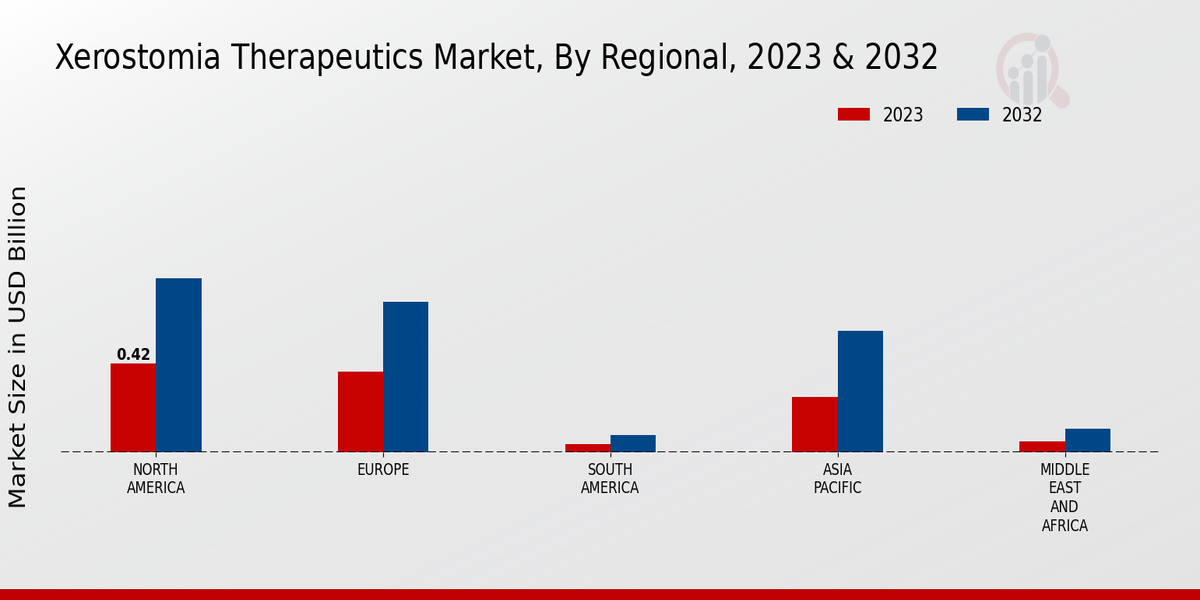Market Growth Projections
The Global Xerostomia Therapeutics Market Industry is projected to experience substantial growth over the coming years. The market value is expected to reach 0.92 USD Billion in 2024 and is anticipated to grow to 2.3 USD Billion by 2035. This growth trajectory reflects a compound annual growth rate (CAGR) of 8.7% from 2025 to 2035. Such projections indicate a robust demand for therapeutic solutions as the prevalence of xerostomia continues to rise. The market's expansion is likely to be driven by advancements in treatment options, increased awareness, and regulatory support, positioning it as a dynamic sector within the healthcare landscape.
Growing Awareness and Diagnosis
There is a notable increase in awareness and diagnosis of xerostomia, which is significantly influencing the Global Xerostomia Therapeutics Market Industry. Healthcare providers are becoming more attuned to the symptoms and implications of dry mouth, leading to improved identification and treatment of affected individuals. Educational campaigns and professional training are enhancing understanding among practitioners, which may lead to earlier interventions. This heightened awareness is likely to drive market growth as more patients seek therapeutic options. The projected CAGR of 8.7% from 2025 to 2035 indicates a robust market response to this growing awareness.
Advancements in Therapeutic Options
Technological advancements in therapeutic options for xerostomia are propelling the Global Xerostomia Therapeutics Market Industry forward. New formulations and delivery systems, such as oral sprays, lozenges, and gels, are being developed to enhance patient compliance and efficacy. For instance, the introduction of mucoadhesive formulations has shown promise in prolonging the therapeutic effect of saliva substitutes. These innovations not only improve patient outcomes but also stimulate market growth. As the industry evolves, the anticipated market value of 2.3 USD Billion by 2035 underscores the potential for these advancements to transform xerostomia management.
Increasing Prevalence of Xerostomia
The rising incidence of xerostomia globally is a primary driver for the Global Xerostomia Therapeutics Market Industry. Factors such as aging populations and the widespread use of medications that cause dry mouth contribute to this trend. It is estimated that approximately 30% of older adults experience xerostomia, which is likely to increase as the global population ages. This growing patient base necessitates effective therapeutic solutions, thereby expanding the market. In 2024, the market is projected to reach 0.92 USD Billion, reflecting the urgent need for innovative treatments to address this common condition.
Regulatory Support for Therapeutics
Regulatory support for the development and approval of xerostomia therapeutics is fostering growth in the Global Xerostomia Therapeutics Market Industry. Government agencies are increasingly recognizing the need for effective treatments for dry mouth, leading to streamlined approval processes for new products. Initiatives aimed at encouraging research and development in this area are likely to enhance the availability of innovative therapies. As regulatory frameworks evolve, they may facilitate faster market entry for new solutions, thereby expanding the therapeutic landscape. This supportive environment is expected to contribute to the market's growth, particularly as new products emerge.
Rising Demand for Oral Health Products
The demand for oral health products that alleviate xerostomia symptoms is on the rise, significantly impacting the Global Xerostomia Therapeutics Market Industry. Consumers are increasingly seeking products that not only provide relief from dry mouth but also promote overall oral health. This trend is evident in the growing popularity of mouthwashes, toothpaste, and chewing gums specifically formulated for dry mouth relief. As the market evolves, manufacturers are responding by developing innovative products that cater to these consumer preferences. This shift in demand is expected to contribute to the market's growth trajectory, aligning with the anticipated increase in market value.
















